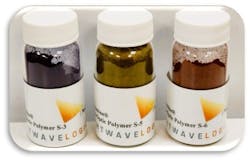Electro-optic polymers are a potential enabler of quantum computing
Max Planck (1858-1947) is recognized as a father of quantum technology. His work as a theoretical physicist and the discovery of energy quanta was recognized with a Nobel Prize in Physics (1918). While dedicating his life to theoretical physics, he is remembered most as an innovator of quantum theory and for his understanding of atomic and subatomic processes.
It would be interesting to have insight into what Planck would think about our world more than a century on from his pathbreaking work. Not only have we evolved beyond delivering post or mail using stamps and envelopes for communication, but we have created a social infrastructure that demands new technologies and solutions for challenging problems. These new technologies now need to look to quantum computing, quantum engineering, and quantum-based mechanics and technology, and use these tools to implement effective and enabling solutions to continue advancement of our society.
Perhaps Planck would be in the middle of this quantum revolution, helping us understand and implement quantum technology into products we can all benefit from. We wonder how excited Planck would be to work on a real quantum computer.
During the past few years, the unequalled potential of computing power is driving the interest and investment in quantum. This is not expected to wane in coming years, especially with the rise of generative artificial intelligence (GenAI) that demands ever-increasing computational processing. It also creates challenges both for electronic chip design and the optical interconnects that carry increased information flow within and around data centers.
While digital-based information flow today is required to upgrade speed and lower power consumption, quantum-computing-based information flow based on qubits has the potential to contain much more information than digital bits and enable massive computing power because of the way qubits interact and behave. Quantum computing using qubits can enable computing power far more than anything feasible with conventional digital computers now.
These tremendous capabilities are enabled by the unique properties of quantum mechanics and the way particles and photons interact under the laws of quantum mechanics. Interesting and strange effects such as superposition, interference, and entanglement can be leveraged significantly. In today’s environment, we are only scratching the surface of a field that is still in its infancy.
One of the enablers of digital computer networks, such as those within data centers, is the use of traditional digital optical modulators. These are devices that encode information on fiber- optic interconnects to enable increased data rates and information flow. Lightwave Logic is a Colorado-based company that sources and creates state-of-the-art organic materials for a class of electro-optic polymers (EOP) called Perkinamine that are used in optical modulator devices.
For optical modulators, the company starts with its own proprietary-designed organic chromophores, which are a key ingredient of polymers, and deposits them onto a silicon chip within standard silicon wafer fabs using standard tooling and equipment. While optical modulators enable headroom for increased data rates and lower power consumption today, EOPs’ similarly high-performance metrics make it suitable for quantum computing.
EOPs are promising for quantum applications both because of their ability to manipulate the properties of photons that can be used for preparing quantum states for qubits and because of their low loss (for preserving the very small signal levels produced by quantum computers), very high EO coefficient (high sensitivity for the low signal levels involved), high radio-frequency (RF) bandwidth (for very short pulses that emanate from quantum computers), and the ability of EOPs to work at cryogenic temperatures to minimize thermal corruption of the qubit quantum states.
EOP materials can also be used as quantum transducers at the ingress and egress of a next-generation quantum computer converting between electron and photon pairs while preserving the quantum entanglement.
The use and functioning of qubits are based on the quantum behavior and interactions of single photons and/or particles or single photon pairs and/or electron pairs and maintaining the integrity of their quantum states, which are easily disturbed if they are not protected from thermal perturbations.
Quantum computers based on the quantum states of electrons, such as Josephson junctions, must be operated at extreme cryogenic temperatures (mK) because of the strong interactions of electrons with thermal perturbations. Those based on photons, for which interactions are not as strong, can be operated at somewhat higher cryogenic temperatures (several K).
By making as much of the system as possible photonic, which enables higher operating temperatures, the power requirements for refrigeration can be reduced to lessen the energy footprint. In view of this, the capability of EOPs to operate at cryogenic temperatures required for quantum computing and quantum transducers can be quite valuable for quantum applications.
Even when the quantum computing engine is based on the quantum states of electrons, such as Josephson junctions, the information must be extracted photonically because of the extreme sensitivity of electrons to thermal disturbance of quantum states and because of the much higher RF loss compared to optical loss for these low signal levels. Since the signal levels are so low, the extreme sensitivity offered by the high EO coefficient of chromophores is important. And because the pulses are so fast, the high bandwidth of EOP based transducers is important.
Planck’s possible perspective
As GenAI changes our lives and we look to quantum computing to solve previously intractable problems, it is healthy to look back. From Planck’s perspective, we have unimagined possibilities before us. One example we discussed is the potential of electro-optic polymers as an enabler of quantum computing. Our hope is that quantum computing in general will enrich the quality of life for all of us.
About the Author
Michael Lebby
Michael Lebby is CEO of Lightwave Logic (Englewood, CO).
John Zyskind
John Zyskind is vice president of engineering for Lightwave Logic (Englewood, CO).
